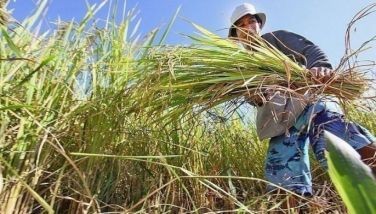RP awash with destructive ‘alien’ plant, animal species
June 3, 2001 | 12:00am
The country is now awash with "alien invasive species" (AIS) of flora and fauna introduced over the years.
Many of these plant and animal species have turned out to be destructive and are now wreaking havoc in the country’s ecosystems, causing great losses to the agriculture, fisheries, and forestry sectors.
A typical example is the golden apple snail (GAS), now popularly known as "golden kuhol."
Originating in the Amazon River Basin in South America, it became established in Florida (United States) and from there it spread to other States and to Europe and Asia.
It was introduced in the Philippines in 1984 through a batch of breeders from Taiwan.
Production of the golden apple snail rapidly expanded because seed stock and tested technologies for its mass production and easy harvesting were available. The GAS were purposely stocked in freshwater areas, released from ponds, or escaped from the rearing facilities of aquaculturists and aquarium hobbyists.
Today, the snail is a serious pest, attacking rice plants, corn, ornamental plants, citrus, and ramie.
Another AIS long been in the Philippines is the water hyacinth, which blocks waterways, limiting boat traffic, fishing, and swimming. It’s shading and crowding of native aquatic reduce biological diversity in aquatic ecosystems.
Cogon has also become a common weed in hot climate countries in Africa, South Asia, and Southeast Asia, including the Philippines.
Now being watched for its possible destructive effects on fish life in the country is the African catfish, which was illegally introduced in the Philippines by a private individual in the early 1980s.
The African hito is predatory in the wild and carnivorous in captivity, eating commercial feeds, animal entrails, and dead animals, and preying on small "ayungin", carp, and tilapia.
These floral and faunal species were among the AIS that were discussed during a two-day scientific meeting billed "Seminar-Workshop in Biodiversity and Management of Alien Invasive Species in the Philippines."
Held recently at the Century Imperial Palace Suites in Quezon City, the conference was organized by the Los Baños-based ASEAN Regional Center for Biodiversity Conservation (ARCBC) and the Protected Areas and Wildlife Bureau (PAWB) of the Department of Environment and Natural Resources (DENR). It was held in observance of International Day for Biological Diversity this year, which had for its theme "Biodiversity Management of Alien Invasive Species."
The seminar-workshop aimed to create awareness and understanding and possibly mitigate the detrimental effects of AIS to biodiversity. Participants were more than a hundred scientists, researchers, and staff members of government and nongovernment agencies, the academe, and civil society.
Speakers were Dr. Theresa Mundita Sison-Lim, PAWD assistant director; Adelina Santos-Borja of the Laguna Lake Development Authority (LLDA); Dr. Rafael D. Guerrero III, executive director of the Philippine Council for Aquatic and Marine Research and Development (PCAMRD); Horacio San Valentin of the DENR-Ecosystems Research and Development Bureau (ERBD); and Dr. Leonardo Florece of the UP Los Baños School of Environmental Science and Management (SESAM).
Alien Invasive Species has been defined by the Convention on Biological Diversity (CBD) as those that are introduced into new habitats by human intervention and usually are invasive or aggressive.
AIS, as described by the US Department of Agriculture, are plants, animals, and microbes not native to a region which, when introduced either accidentally or intentionally, out-compete native species for available resources, reproduce prolifically, and dominate regions and ecosystems.
Throughout the world, AIS have been causing grave problems on ecosystems.
For instance, about 20 percent of all freshwater fish are at risk of becoming extinct in the near future unless the present situation is reversed.
Invasive plant species now cover an estimated 100 million acres in the US and are spreading annually across three million additional acres. American farmers spend billions of dollars every year on pesticides to destroy invasive plants and weeds.
Some $4.5 million is devoted annually to implement a comprehensive inter-agency program to prevent the spread of the brown tree snake and control this pest in Guam.
AIS have been classified into microorganisms (avian malaria, banana bunchy top virus, rinderpest virus), aquatic plants (water hyacinth), land plant (cogon, mimosa, African tulip tree), aquatic invertebrates (green crab, marine clam), land invertebrate (common malaria mosquito, golden apple snail, common wasp), amphibian (bullfrog, cane toad), fish (carp, Mozambique tilapia), bird (Indian myna bird, red-vested bulbul), reptile (brown tree snake), and mammal (domestic cat, goat, mouse, pig, rabbit, and red fox).
During the discussions led by resource persons and ARCBC co-directors Gregorio Texon and Dr. John McKinnon, the participants hammered out recommendations on how to prevent, control, or eradicate AIS.
These include the following:
• A risk assessment should be done before new species are introduced in the country to avoid future problems that these AIS can cause.
• Research should be started or continued to determine beneficial or invasive attributes of introduced alien species. The results of the research should be disseminated to the appropriate parties.
• Interagency efforts through task forces should be mobilized.
• Deficient policies should be enhanced.
• Public awareness raising and implementation of advocacy campaigns should be launched. This should include marketing of researches conducted by the academe.
• Baseline on endemic and indigenous species should be established. The PAWB should set up a metabase that will enable agencies/interested parties to locate where these data are available and which agency to approach to obtain the data they are interested in.
Texon assured the participants that the documentation of the proceedings, including their recommendations and agreements, will be forwarded to the Philippine Council for Sustainable Development (PCSD), to the House of Representatives, and directly to the Office of the DENR Secretary.
Many of these plant and animal species have turned out to be destructive and are now wreaking havoc in the country’s ecosystems, causing great losses to the agriculture, fisheries, and forestry sectors.
A typical example is the golden apple snail (GAS), now popularly known as "golden kuhol."
Originating in the Amazon River Basin in South America, it became established in Florida (United States) and from there it spread to other States and to Europe and Asia.
It was introduced in the Philippines in 1984 through a batch of breeders from Taiwan.
Production of the golden apple snail rapidly expanded because seed stock and tested technologies for its mass production and easy harvesting were available. The GAS were purposely stocked in freshwater areas, released from ponds, or escaped from the rearing facilities of aquaculturists and aquarium hobbyists.
Today, the snail is a serious pest, attacking rice plants, corn, ornamental plants, citrus, and ramie.
Another AIS long been in the Philippines is the water hyacinth, which blocks waterways, limiting boat traffic, fishing, and swimming. It’s shading and crowding of native aquatic reduce biological diversity in aquatic ecosystems.
Cogon has also become a common weed in hot climate countries in Africa, South Asia, and Southeast Asia, including the Philippines.
Now being watched for its possible destructive effects on fish life in the country is the African catfish, which was illegally introduced in the Philippines by a private individual in the early 1980s.
The African hito is predatory in the wild and carnivorous in captivity, eating commercial feeds, animal entrails, and dead animals, and preying on small "ayungin", carp, and tilapia.
These floral and faunal species were among the AIS that were discussed during a two-day scientific meeting billed "Seminar-Workshop in Biodiversity and Management of Alien Invasive Species in the Philippines."
Held recently at the Century Imperial Palace Suites in Quezon City, the conference was organized by the Los Baños-based ASEAN Regional Center for Biodiversity Conservation (ARCBC) and the Protected Areas and Wildlife Bureau (PAWB) of the Department of Environment and Natural Resources (DENR). It was held in observance of International Day for Biological Diversity this year, which had for its theme "Biodiversity Management of Alien Invasive Species."
The seminar-workshop aimed to create awareness and understanding and possibly mitigate the detrimental effects of AIS to biodiversity. Participants were more than a hundred scientists, researchers, and staff members of government and nongovernment agencies, the academe, and civil society.
Speakers were Dr. Theresa Mundita Sison-Lim, PAWD assistant director; Adelina Santos-Borja of the Laguna Lake Development Authority (LLDA); Dr. Rafael D. Guerrero III, executive director of the Philippine Council for Aquatic and Marine Research and Development (PCAMRD); Horacio San Valentin of the DENR-Ecosystems Research and Development Bureau (ERBD); and Dr. Leonardo Florece of the UP Los Baños School of Environmental Science and Management (SESAM).
Alien Invasive Species has been defined by the Convention on Biological Diversity (CBD) as those that are introduced into new habitats by human intervention and usually are invasive or aggressive.
AIS, as described by the US Department of Agriculture, are plants, animals, and microbes not native to a region which, when introduced either accidentally or intentionally, out-compete native species for available resources, reproduce prolifically, and dominate regions and ecosystems.
Throughout the world, AIS have been causing grave problems on ecosystems.
For instance, about 20 percent of all freshwater fish are at risk of becoming extinct in the near future unless the present situation is reversed.
Invasive plant species now cover an estimated 100 million acres in the US and are spreading annually across three million additional acres. American farmers spend billions of dollars every year on pesticides to destroy invasive plants and weeds.
Some $4.5 million is devoted annually to implement a comprehensive inter-agency program to prevent the spread of the brown tree snake and control this pest in Guam.
AIS have been classified into microorganisms (avian malaria, banana bunchy top virus, rinderpest virus), aquatic plants (water hyacinth), land plant (cogon, mimosa, African tulip tree), aquatic invertebrates (green crab, marine clam), land invertebrate (common malaria mosquito, golden apple snail, common wasp), amphibian (bullfrog, cane toad), fish (carp, Mozambique tilapia), bird (Indian myna bird, red-vested bulbul), reptile (brown tree snake), and mammal (domestic cat, goat, mouse, pig, rabbit, and red fox).
During the discussions led by resource persons and ARCBC co-directors Gregorio Texon and Dr. John McKinnon, the participants hammered out recommendations on how to prevent, control, or eradicate AIS.
These include the following:
• A risk assessment should be done before new species are introduced in the country to avoid future problems that these AIS can cause.
• Research should be started or continued to determine beneficial or invasive attributes of introduced alien species. The results of the research should be disseminated to the appropriate parties.
• Interagency efforts through task forces should be mobilized.
• Deficient policies should be enhanced.
• Public awareness raising and implementation of advocacy campaigns should be launched. This should include marketing of researches conducted by the academe.
• Baseline on endemic and indigenous species should be established. The PAWB should set up a metabase that will enable agencies/interested parties to locate where these data are available and which agency to approach to obtain the data they are interested in.
Texon assured the participants that the documentation of the proceedings, including their recommendations and agreements, will be forwarded to the Philippine Council for Sustainable Development (PCSD), to the House of Representatives, and directly to the Office of the DENR Secretary.
BrandSpace Articles
<
>
- Latest
Latest
Latest
November 9, 2024 - 3:43pm
By E.H. Edejer | November 9, 2024 - 3:43pm
June 9, 2024 - 5:55pm
By Alberto Peña | June 9, 2024 - 5:55pm
May 24, 2024 - 10:00am
May 24, 2024 - 10:00am
May 14, 2024 - 3:43pm
By Ian Laqui | May 14, 2024 - 3:43pm
April 10, 2024 - 5:12pm
By Ian Laqui | April 10, 2024 - 5:12pm
Recommended



























